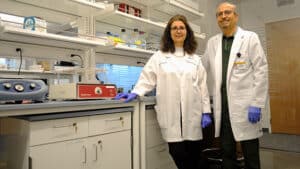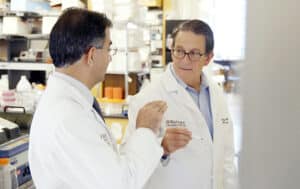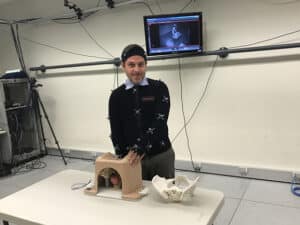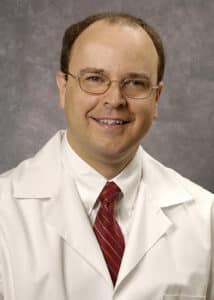Missouri is known for its insistence on visible, tangible proof. And one area where you can see results is in the promising research being conducted at four Missouri medical schools: University of Missouri-Columbia (MU), Washington University (Wash U), Saint Louis University (SLU) and University of Missouri-Kansas City (UMKC).
MU: Celebrating A Cell Success
Type 1 diabetes—or insulin-dependent diabetes mellitus (IDDM )—was once called juvenile diabetes since it typically develops in children, teens, and young adults. But it can happen at any age. With this autoimmune disease, your pancreas doesn’t make insulin. Without insulin, blood sugar can’t enter your cells to fuel energy. Blood sugar then builds up in your bloodstream and damages your body, causing many of the symptoms and complications of diabetes. Although IDDM can be managed successfully, there’s currently no cure for this chronic condition. But a cure appears to be Fas approaching.
Fas (a membrane protein in the “death receptor family”) can be cross-linked with its ligand FasL (a transmembrane protein in the tumor necrosis factor family). When the two bind, the result is “apoptosis” (cell death). It’s one way the body gets rid of unneeded or abnormal cells. Fas/FasL interactions play an important role in regulating the immune system.

A team of researchers from the University of Missouri, Georgia Tech, and Harvard successfully employed a novel treatment for IDDM in a large animal model. Their method involves transplanting insulin-producing pancreas cells—islets—from a donor along with FasL to a recipient, without the need for long-term immunosuppressive drugs. Although those drugs prevent rejection of transplanted cells, they are not “specific,” and they kill good cells as well as bad. So, the prospect of eliminating the need for those drugs is groundbreaking.
The two lead MU researchers, Dr. Haval Shirwan and Dr. Esma Yolcu, are professors of child health and molecular microbiology and immunology in the MU School of Medicine. They joined the MU faculty in spring 2020, and are part of the first group of researchers to begin working in the Roy Blunt NextGen Precision Health building.
“We are using this for Type 1 diabetes,” Shirwan says. “But also we are using this technology in cancer settings … it’s a ‘platform technology.’” The team hopes that in combination with other biologics it’s making in-house, it will be able to target cancers as well. “We prevented the rejection of the transplanted islets in preclinical models without a need for immunosuppression. That was quite encouraging. Now, we are getting ready for the phase I clinical trial (which will test the technology on humans). Hopefully next year.”
Shirwan and Yolcu have dedicated more than 22 years of their lives to the development of this platform technology. Not only are the two wed in their pursuit of a cure for Type 1 diabetes, but they’re also wed as husband and wife.
For Yolcu, talking with young patients and their families only furthers her resolve. “I assure them that this is really my goal in my scientific career: that before I retire and leave the scientific field, I’ll have this impactful … potentially a cure, with our concept.”
The duo is extremely grateful for the support and grants they’ve received from the Juvenile Diabetes Research Foundation and the National Institutes of Health.
Wash U: T-ing Up A Cancer Cure
Just a couple hours east of Columbia, but headed in the same direction research-wise, physicians at Washington University School of Medicine in St. Louis are also pursuing extremely promising cell research.
Therapies that employ the body’s immune cells to attack cancer have shown encouraging results fighting some of the most difficult-to-treat blood cancers. Wash U researchers are using genetically modified T cells—known as CAR-T cells—to attack certain types of T-cell leukemias and lymphomas that have recurred after a stem cell transplant. The difficulty with using T cells this way is that they don’t have the ability to differentiate—in other words, the therapeutic cells can end up killing each other.

To solve this problem, Dr. John DiPersio, MD, Ph.D, the Virginia E. and Sam J. Golman Professor of Medicine in Oncology, and his team have genetically modified the CAR-T cells rendering them invisible to one another, so they can only attack the cancerous T cells. Genetic modifications also make it possible to use T cells from any donor—and prevent graft-versus-host disease, which happens when the donor T cells attack the patient’s healthy tissues.
“Cancerous T cells and healthy T cells have exactly the same protein—CD7—on their surfaces,” says DiPersio, “But if we program T cells to target CD7, they would attack the cancerous cells and each other, thus undermining this approach.” he says. “To prevent this T cell fratricide, we used CRISPR/Cas9 gene editing to remove CD7 from healthy T cells, so they no longer carry the target.”
DiPersio’s lab has also recently proven that giving therapeutic donor T cells along with a long-acting form of a protein called interleukin-7 (IL-7) causes the therapeutic T cells to expand more and survive for a longer time, creating a better anti-cancer effect.
In another cell-based immunotherapy, Wash U researchers are improving the immune system’s “natural killer (NK) cells” to treat certain blood cancers. NK cells fight off viruses and are able to kill some cancer cells, but cancers frequently learn how to avoid these immune lookouts.
Dr. Todd Fehniger, MD, PhD, and his team have developed a way to harvest the patient’s own NK cells and activate the cells by exposing them to a cocktail of signaling molecules. This cocktail “trains” the cells to attack cancer cells. These attacker cells are then returned to the patient and expand as “living drugs.” NK cell-based immunotherapies show promise in treating blood cancers, and clinical trials are under development for solid tumors, such as melanoma.
UMKC: A More Sound Approach to the OR
The operating room (OR) is one of the most critical areas in a hospital. Patients literally put their lives in the hands of a surgical team who work in concert to perform procedures that save or prolong lives. Patient safety and surgical success depend on that team’s ability to clearly communicate with one another.
Ironically, while an OR surgical team must operate like a well-oiled machine, much of the surgical machinery itself is loud and noisy. This can interfere with communication. When you layer on “human-caused” sound, such as chit chatting, the stage is set for mistakes.

Recognizing this, Dr. Gary Sutkin, a pelvic reconstructive surgeon at UMKC with experience studying OR surgical team communication, joined others on a multidisciplinary research team to conduct a study comparing machine versus human-caused sounds for their loudness and distraction, and potential impact on surgical team communication. The 5-person research team included an ethnographic researcher with experience studying interprofessional communication and teamwork, as well as a cognitive scientist with expertise in speech science, acoustic, and psychoacoustic methods.
“I work with talented individuals from other disciplines, who care about surgical safety and want to use their expertise to create new ways to approach an old problem,” Sutkin says.
The researchers conducted an anonymous survey of OR staff at UMKC hospital, an urban safety net facility for the uninsured and underinsured and a partner with its academic medical center, including surgical residencies and fellowships.
Respondents included circulating nurses, anesthetists, and attending and resident surgeons. Years of OR experience varied. Of the 60 respondents, 93 percent agreed to the statement, ‘‘Noise in the OR interferes with your ability to understand colleagues or ability for them to understand you.’’
In addition, Sutkin and his colleagues attended nearly 60 live surgeries and recorded a series of machine and human-caused sounds, measuring their acoustical intensity. The sound levels were also plotted visually using spectral analysis.
“So many of the sounds were louder than we anticipated,” he says. “For example, our electronic Bovie knife (an electrosurgery device) was as loud as a food blender or a garbage disposal.”
The researchers found human-caused sounds were comparable to machine-caused sounds in their mean peak decibel levels, yet were rated as more interfering. “Moving a metal step stool across the floor was as loud as a jackhammer,” Sutkin says.
The spectral analysis showed both machine and human-caused sound sources obscured the surgeon’s instructions. The research team concluded: “Avoidable human-caused sounds are a major source of disruption in the OR and interfere with communication and job performance. We recommend surgical team training to minimize these distractions.” The findings were published in the World Journal of Surgery in March of 2022.
SLU: A Treatment Triumph
About 100,000 Americans are affected by the genetic lung and liver disease Homozygous ZZ alpha-1 antitrypsin (AAT) Deficiency. Alpha-1 antitrypsin is a protein made by the liver that protects the lungs. If the AAT proteins are misshapen, due to inheriting a defective AAT gene, then they get stuck in the liver cells and cannot reach the lungs. AAT deficiency can affect children and adults. Diagnosis can be tricky, because some people have no symptoms and don’t develop complications. Many people live their lives not even knowing they have AAT, while others have life-threatening complications.

According to Dr. Jeffrey Teckman, the Patricia and James Monteleone Endowed Chair Director of Pediatric Gastroenterology and Hepatology, and a professor of Pediatrics and Biochemistry at SLU’s Cardinal Glennon Children’s Hospital, the inherited deficiency occurs in 1 in 3,500 births. Both parents must carry at least one defective gene for it to be passed on. Because there has never been a treatment for AAT liver damage, Teckman was eager to play a part in finding one. He co-authored a research paper on the disease and new treatment as one of 13 MDs who contributed to a recently published article in the New England Journal of Medicine.
The article presents the results of a phase II clinical trial in adults with AAT. It investigated the safety and efficacy of the drug fazirsiran, an RNA interference therapeutic (RNAi). RNAi therapeutics essentially “silence” or turn off the production of specific genes that cause or contribute to disease. Many physicians feel this drug class has the potential to make a profound impact on modern medicine.
Although the trial size was small, the results were sizable in their significance: Patient improvement after 6-12 months which continued as the trial progressed. Fazirsiran was associated with a strong reduction of Z-AAT concentrations in the liver and concurrent improvements in evidence of liver damage. The results were “.remarkable and unexpected,” Teckman says. So much so, he says he started crying when he read them. It meant a treatment for a disease that’s never had one.
“I’ve worked in this disease community as not only a researcher, but also a volunteer in education and advocacy, for many years. I’ve lost a lot of friends to this condition, but for the first time, hope for a liver cure is close.”
Next up for Teckman and the research team at SLU? A phase III clinical trial in adults with AAT that will be conducted in 2023, with SLU serving as one of the testing sites.
Related Posts
How to Get a Missouri Marijuana Card
Learn how to get your medical marijuana card by certified physicians in Missouri.
Revitalizing Missouri Downtowns
Here’s how Missourians are working together to revitalize downtowns across the state.
How to Get a Missouri Medical Marijuana Card Online in 10 Minutes
Learn how the nation’s leading cannabis telemedicine platform can help you get a Missouri medical marijuana card in minutes.



